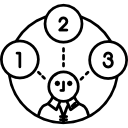Data types: Difference between revisions
Mr. MacKenty (talk | contribs) No edit summary |
Mr. MacKenty (talk | contribs) No edit summary |
||
| Line 5: | Line 5: | ||
Data types are important in programming languages because they help the compiler or interpreter more efficiently allocate memory. Data types tells MMU that how much memory requirement it has before the program compiles. Also, the data type defines which operations can safely be performed to create, transform and use the variable in another computation. | Data types are important in programming languages because they help the compiler or interpreter more efficiently allocate memory. Data types tells MMU that how much memory requirement it has before the program compiles. Also, the data type defines which operations can safely be performed to create, transform and use the variable in another computation. | ||
The main purpose of a type system is to reduce possibilities for bugs in computer programs by defining interfaces between different parts of a computer program, and then checking that the parts have been connected in a consistent way. This checking can happen statically (at compile time), dynamically (at run time), or as a combination of both. Type systems have other purposes as well, such as expressing business rules and enabling certain compiler optimizations. | |||
== Primitive types == | == Primitive types == | ||
Revision as of 06:28, 11 May 2020

Data type determines what sort of data is being stored and how it will be used by the program. In computer science and computer programming, a data type or simply type is an attribute of data which tells the compiler or interpreter how the programmer intends to use the data [2].
Data types are important in programming languages because they help the compiler or interpreter more efficiently allocate memory. Data types tells MMU that how much memory requirement it has before the program compiles. Also, the data type defines which operations can safely be performed to create, transform and use the variable in another computation.
The main purpose of a type system is to reduce possibilities for bugs in computer programs by defining interfaces between different parts of a computer program, and then checking that the parts have been connected in a consistent way. This checking can happen statically (at compile time), dynamically (at run time), or as a combination of both. Type systems have other purposes as well, such as expressing business rules and enabling certain compiler optimizations.
Primitive types[edit]
Not all languages have the same primitive data types. Please see the table below for a representative list of types:
| Data type | Definition | Notes |
|---|---|---|
| Int | Integer. The mathematical name for any positive or negative whole number. | This is a common primitive data type |
| Float | A float is a number that has a fractional or decimal part. | This is a common primitive data type |
| Boolean | A boolean is simply true or false, and can be nothing other than true or false | This is a common primitive data type |
| String | A string is used to store characters, which could be text or numbers. | This is a common primitive data type |
| Pointer / Reference | This type points to (or references) a location in memory | This is a common primitive data type in compiled languages. |
| Char | Character. This data type stores one single character. | This is a common primitive data type in compiled languages. |
| Date / Time | This data types stores data as date and time | This is not a "classic" primitive data type, but shows up often enough. |